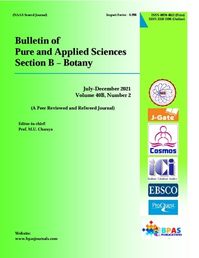Preparation and Applications of Anti-Mosquito Herbal Dhoopwati by using Mosquito Repellent Plants
DOI:
https://doi.org/10.48165/Keywords:
Mosquito, Repellent, Dhoop, Herbal plants, Eco-friendlyAbstract
Herbal dhoop is natural product which is composed of natural mosquito repellent plant parts. It is made from unique blend of plant extracts and aromatic oils which repels the mosquito or insects away and it is safe, non -toxic, eco-friendly.In the present study the essential oils and plants extract were tested at different concentrations with handmade mosquito stick at the corner of the room where large number of mosquitoes are present. The results revealed that the different combinations of herbal plants showmosquito repellent activities. Camphor, lemon grass, Neem, Tulsi, and Vitexnirgundis how highest mosquito repellences and no irritability was reported on the skin. Hence it is safe and eco-friendly in use.
Downloads
References
Service, M.W. (1993). Mosquitoes (Culicidae). Medical insects and arachnids, 120-240.
Specos, M.M., Garcia, J.J., Tornesello, J., Marino, P., Vecchia, M.D., Tesoriero, M.D., and Hermida, L.G. (2010). Microencapsulated citronella oil for
mosquito repellent finishing of cotton textiles. Transactions of the Royal Society of Tropical Medicine and Hygiene, 104(10), 653- 658.
Trivedi, A., Rai, P., Kumar, J., and Trivedi, C.A. (2018). Formulation of low smoke herbal mosquito repellent sticks by using different essential oils. The Pharma Innovation Journal, 7(4), 173-175.
Madhumathy, A.P., Aivazi, A.A., and Vijayan, V.A. (2007). Larvicidal efficacy of Capsicum annum against Anopheles stephensi and Culexquinquefasciatus. Journal of Vector Borne Diseases, 44(3), 223.
Hallem, E.A., Nicole Fox, A., Zwiebel, L.J., and Carlson, J.R. (2004). Mosquito receptor for human-sweat odorant. Nature, 427(6971), 212-213.
Sah, M.L., Mishra, D., Sah, S.P., and Rana, M. (2010). Formulation and evaluation of herbal mosquito repellent preparations. Indian drugs, 47(4), 45-50.
Patil, C.D., Patil, S.V., Borase, H.P., Salunke, B.K., and Salunkhe, R.B. (2012). Larvicidal activity of silver nanoparticles synthesized using Plumeriarubra plant latex against Aedesaegypti and Anopheles stephensi. Parasitology Research, 110(5), 1815-1822.
Maia, M.F., and Moore, S.J. (2011). Plant based insect repellents: a review of their
efficacy, development and testing. Malaria journal, 10(1), 1-15.
Soonwera, M. And Phasomkusolsil, S. (2015). Efficacy of Thai herbal essential oils as green repellent against mosquito vectors. ActaTropica, 142, 127-130.
Mandal, S. (2011). Repellent activity of Eucalyptus and Azadirachta indica seed oil against the filarial mosquito Culex quinquefasciatus Say (Diptera: Culicidae) in India. Asian Pacific Journal of Tropical Biomedicine, 1(1), S109-S112.
Yap, H.H., Tan, H.T., Yahaya, A.M., Baba, R. O. H. A. I. Z. A. T., Loh, P.Y., and Chong, N.L. (1990). Field efficacy of mosquito coil formulations containing d allethrin and d-transallethrin against indoor mosquitos especially Culex
quinquefasciatus Say. The Southeast Asian journal of tropical medicine and public health, 21(4), 558-563.
Tripathi, A.K., Prajapati, V., Ahmad, A., Aggarwal, K.K., and Khanuja, S.P. (2004). Piperitenone oxide as toxic, repellent, and reproduction retardant toward malarial vector Anopheles stephensi (Diptera: Anophelinae). Journal of Medical Entomology, 41(4), 691-698.
Dua, V.K., Pandey, A.C., Raghavendra, K., Gupta, A., Sharma, T., and Dash, A.P. (2009). Larvicidal activity of neem oil (Azadirachta indica) formulation against mosquitoes. Malaria Journal, 8(1), 1-6.
de Souza Tavares, W., Akhtar, Y., Gonçalves, G.L.P., Zanuncio, J.C., and Isman, M.B. (2016). Turmeric powder and its derivatives from Curcuma
longarhizomes: insecticidal effects on cabbage looper and the role of synergists. Scientific reports, 6(1), 1-11.
Ezena, G.N. (2015). Exploiting the Insecticidal Potential of the Invasive Siam Weed, Chromolaena odorata L. (Asteraceae) in the Management of major pests of Cabbage, Brassica oleracea var. capitata and Their Natural Enemies for Enhanced Yield in the Moist Semi-Deciduous Agro Ecological Zone of Ghana (Doctoral dissertation, University of Ghana).
Jiraungkoorskul, K., and Jiraungkoorskul, W. (2015). Larvicidal and histopathological effects of Cassia siamea leaf extract against Culex quinquefasciatus. Tropical Life Sciences Research, 26(2), 15.
Mona, M.A.D. (2020). Insecticidal potential of cardamom and clove extracts on adult red palm weevil Rhynchophorus ferrugineus. Saudi Journal of Biological
Sciences, 27(1), 195-201.
Peterson, C.J., and Coats, J.R. (2011). Catnip essential oil and its nepetalactone isomers as repellents for mosquitoes. In Recent Developments in Invertebrate Repellents (pp. 59-65). American Chemical Society.
Rahuman, A.A., Gopalakrishnan, G., Venkatesan, P., and Geetha, K. (2008). Larvicidal activity of some Euphorbiaceae plant extracts against Aedes aegypti and Culex quinquefasciatus (Diptera: Culicidae). Parasitology research, 102(5), 867-873.




